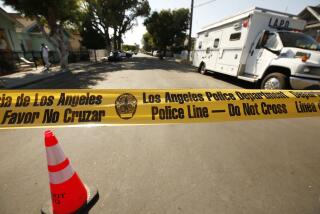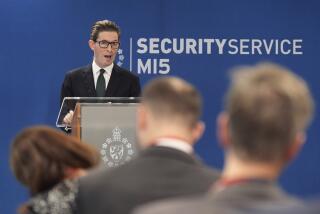London car bombs renew fears
- Share via
LONDON — Police defused two car bombs packed with gasoline and nails Friday after they were found in the heart of the crowded theater and tourist district, generating renewed fears of terrorism and prompting a police clampdown that created near gridlock through much of the city center.
The failed attack, using what authorities said were a pair of explosives-packed Mercedeses, came two days after Gordon Brown became prime minister and barely a week before the second anniversary of the devastating July 7 suicide bombings on the London transit system.
The normally thriving Piccadilly Circus area, nearby Haymarket and Park Lane, a major artery, were closed for the day, leaving bewildered tourists and Londoners walking unfamiliar streets searching for their hotels, cars or the quickest alternative routes home.
The first bomb was found by officers and explosives experts called to the Tiger Tiger nightclub in the Haymarket at 1 a.m., after an ambulance crew treating a club-goer reported seeing smoke inside a parked silver Mercedes.
Investigators found a large number of nails, several containers of gasoline, and propane gas cylinders primed to explode in the car, said Deputy Assistant Commissioner Peter Clarke, head of Scotland Yard’s counter-terrorism command.
“If the device had detonated, there could have been significant injury or loss of life,” Clarke said. “The vehicle was parked in one of the busiest parts of central London in the early hours of Friday morning when many, many people were leaving nightclubs and other places after an evening out.”
The Tiger Tiger is a three-level club with a capacity of more than 1,700. With a dance floor, restaurant and several bars, the club is popular with city workers and tourists who head to the West End. The dance floor is usually packed, particularly toward the end of the week, and Thursday was a crowded ladies’ night.
By 11 a.m., the car had been loaded into a truck and taken away for forensic examination.
The second car, also packed with fuel, gas canisters and nails, was found in an underground impound lot about 2 p.m. on Park Lane in the district where the U.S. Embassy is located, Clarke said. But it had been ticketed for illegal parking nearly 12 hours earlier and towed to the lot from Cockspur Street just off the Haymarket, around the corner from where the first car was found.
The blue Mercedes, like the first car, was “potentially viable” as a bomb, and the two vehicles were “clearly linked,” Clarke said. The discovery of the second bomb, he said, “is obviously troubling. It reinforces the need for the public to be alert.”
Security officials combed the areas for clues and took away a mass of footage from scores of street surveillance cameras.
In the Haymarket area, the streets around Piccadilly Circus, with its heavy concentration of theaters, cinemas, shops, restaurants and offices, were eerily empty as people were barred from tourist attractions, workplaces and upscale apartments. Fleet Street and nearby Chancery Lane in East London were also closed for a time as police checked another suspicious car.
By late Friday evening, Park Lane had been reopened but the Haymarket remained cordoned off as police continued their investigation. Performances of “The Phantom of the Opera” and “The Last Confession” at two major theaters in the Haymarket were canceled.
Another police spokesman, Assistant Commissioner Tarique Ghaffur, said, “I’d like to reassure Londoners we’re doing everything possible to make them safe. We’re putting out extra patrols, and we’ve reviewed plans for the weekend.”
Local media reported that the domestic security agency MI5 canceled leave for its front-line personnel and that security was being reviewed for high-profile events such as Wimbledon and a gay pride march through central London.
Brown, who took over from Tony Blair on Wednesday and formed his government Thursday, found that instead of discussing new policies or constitutional change, his first Cabinet meeting addressed an immediate terrorist threat.
“We are currently facing the most serious and sustained threat to our security from international terrorism,” new Home Secretary Jacqui Smith said after the meeting.
The government’s emergencies committee, known as Cobra, was to meet this morning.
President Bush, who was at his family’s vacation home in Kennebunkport, Maine, was briefed twice Friday about the situation: early in the morning by national security advisor Stephen Hadley and about 2 p.m. by domestic security advisor Frances Townsend.
White House spokesman Tony Snow said there was no indication of a threat to the United States and that the terrorism alert status would not be raised.
“What we are doing is obviously suggesting that everybody be vigilant, but again, let me reiterate there’s no specific or credible evidence of any kind of threat to the United States,” Snow said.
“It’s terrorism,” he said, but added: “There’s no established connection with any organization at this point.”
Clarke refused to speculate about the timing of the attempted attacks, coming just ahead of the anniversary of the July 7, 2005, terrorist bombings that killed 52 people on London subway trains and a bus. He also would not comment on any connection to groups abroad or to previous plots for which several men have been convicted.
In November, Dhiren Barot was given a life sentence for masterminding plots to use cars packed with charges to explode under buildings and in tunnels in London and the United States. Last month, seven men were sentenced to as much as 26 years in prison for conspiring with Barot to develop the plots.
Terrorism analyst Anthony Glees from Brunel University in London said in a BBC interview that the lack of intelligence warning about imminent attacks “must be a cause for concern.”
He said the car bombs were “similar to devices found in Afghanistan and Iraq” and called them “an Al Qaeda memo to Gordon Brown and the British people to show them they are still in business.”
The timing is consistent, he said, “with what we know to be Al Qaeda’s interest in propaganda coups,” referring to the new Brown government and the anniversary of the transit attacks.
Times staff writer Maura Reynolds in Kennebunkport, Maine, contributed to this report.
*
(BEGIN TEXT OF INFOBOX)
Terrorism in London
June 29: An attack in London’s theater district fails, with police defusing bombs made of gasoline, propane gas and nails in two cars. One was found parked outside a nightclub; the other had been towed from a nearby street to an impound lot, where the bomb was found hours later.
Aug. 10, 2006: Authorities arrest 25 people in London accused in a terrorist plot to simultaneously blow up 10 aircraft flying from Britain to the U.S. using explosives smuggled in hand luggage. Seventeen suspects have been charged.
July 21, 2005: Explosive devices on three subway trains and a double-decker bus fail to explode when triggered by attempted suicide bombers. Six men are on trial in London in the attacks.
July 7, 2005: Suicide bombers detonate explosives on three subway trains and a double-decker bus during the morning rush hour, killing 52 people and injuring hundreds.
March 30, 2004: Eight men in an Al Qaeda-linked sleeper cell are arrested on suspicion of plotting attacks that included detonating radioactive “dirty bombs” in crowded areas in London and blowing up busy subways under the Thames River. The leader is sentenced in November 2006 to a life term. Seven accomplices are sentenced in May to 15 to 26 years.
Jan. 5, 2003: Police raid a London apartment and arrest nine people accused of plotting to spread the deadly toxin ricin in the city. No traces of ricin are found, although scientists say evidence shows attempts to make the poison. None of the men were charged in connection with the ricin, although one was convicted in the fatal stabbing of a police officer during his arrest.
Sources: Times staff; the Associated Press
More to Read
Sign up for Essential California
The most important California stories and recommendations in your inbox every morning.
You may occasionally receive promotional content from the Los Angeles Times.













